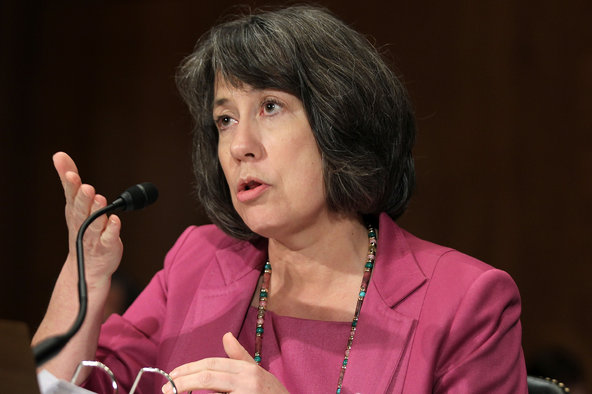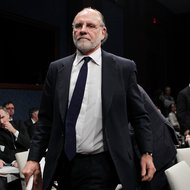 Alex Wong/Getty Images“I hope the regulators move forward with tougher regulations,” said Sheila Bair, an ex-chairwoman of the F.D.I.C.
Alex Wong/Getty Images“I hope the regulators move forward with tougher regulations,” said Sheila Bair, an ex-chairwoman of the F.D.I.C.
Banks have been reporting steady growth in earnings since soon after the financial crisis. With the latest reports rolling in, analysts think the banks’ first-quarter profits will be their best ever.
But as welcome as such profits are to the banks, they may also become a source of discomfort. The ballooning bottom lines could embolden the lawmakers and regulators who want to introduce additional measures to overhaul the banking system.
After the financial crisis, many officials involved in the regulatory revamp feared that tougher rules, like caps on bank assets, could destabilize the financial system and harm economic growth. It is a view that prominent bankers and lobbyists have also voiced.
Despite industry opposition to new rules, the buoyant bank profits could add to the ammunition that influential figures in Washington are using to advocate for more radical ideas to overhaul the banks.
“I hope the regulators move forward with tougher regulations,” said Sheila C. Bair, a former chairwoman of the Federal Deposit Insurance Corporation, a primary bank regulator, and now a senior adviser at the Pew Charitable Trusts. “This wouldn’t endanger the economic recovery.”
Much has been done to strengthen banks since the financial crisis. The Dodd-Frank legislation, which Congress passed in 2010, and international banking standards known as the Basel III rules are forcing banks to hold safer assets, curtail trading activities and set aside more capital to absorb potential losses.
Even so, there is bipartisan support to do more. Most recently, Senator Sherrod Brown, Democrat of Ohio, and Senator David Vitter, Republican of Louisiana, said that they planned to introduce a bill that would require banks to hold considerably more capital. If passed, such a requirement is likely to prompt the largest banks to shrink in size. While a draft of the legislation does not stipulate a maximum size for banks, it requires financial firms with more than $400 billion of assets to hold additional capital. Big banks like Citigroup and Bank of America well exceed that amount, as do Wall Street firms like Morgan Stanley, but regional lenders would fall under that threshold.
The restlessness over the big banks extends beyond Congress.
Daniel K. Tarullo, the Federal Reserve governor who oversees regulation, floated an idea last year for limiting bank size. And Thomas M. Hoenig, vice chairman at the F.D.I.C., has been pushing the overhaul of large, complex banks as well as more rigorous capital standards.
The banking industry might be able to bear more regulations, given how it has fared under earlier measures. In some ways, the banks have thrived despite the added costs of all the new rules and demands since 2008.
Dick Bove, a bank analyst at Rafferty Capital Markets, estimates that F.D.I.C.-insured banks will earn $39 billion in the first quarter of this year, which would be a record quarterly showing. “No one can argue that banks were hurt from a profit standpoint by regulation,” he said.
The financial overhauls of the last four years don’t appear to have held banks back from indulging in activities that facilitate economic growth. Helped by Wall Street financial firms, American companies have raised huge amounts in capital markets since the crisis. Last year, corporations issued $940 billion of bonds, a record amount, according to Dealogic, a data provider. This has happened even as investment banks scaled back their operations to get ready for regulations they vocally oppose, like the so-called Volcker Rule.
The overhaul doesn’t appear to have hurt the housing market, either. Large lenders like Wells Fargo have profited well from the recent boom in mortgage refinancing. That activity has also helped consumers, through sharply lower borrowing rates for millions of homeowners.
Banks are also making significantly more loans to companies, which bolsters the economy and job growth in many parts of the country. There is even evidence that the overhaul may have helped the banks become better run. Citigroup, which was subject to much regulatory pressure, is more streamlined and reported strong first-quarter earnings this week.
Little of this might have been expected after hearing past warnings from bankers. In 2011, Jamie Dimon, chief executive of JPMorgan Chase, said that the proposed rules to overhaul derivatives, a commonly used financial instrument, “would damage America.” He also said that the Basel rules were “anti-American.” Comment letters filed by lobbyists with regulators used sophisticated-looking models to show how rules could hold back the economy.
“As far as the banks are concerned, there is never a good time to raise capital or increase regulation,” Ms. Bair said. “When times are bad, they say it could hurt things, and when times are good, they say they don’t need it.”
Some analysts, however, caution against reading too much into the banks’ strong profits.
Though banks have been preparing for new rules for months, many of them have not been fully executed, which means the true costs of the measures will not be known until later.
Mr. Bove says that, while bank profits have hardly suffered from new regulation, their customers have. Lenders have simply passed on many of the costs, mostly in the form of new fees, he said. “The government aimed a Stinger missile at the banking industry and missed and hit the consumer instead,” said Mr. Bove, who also notes that loans to small business are still weak.
In addition, bank profits may not be as strong as they look, say some analysts. Earnings appear less impressive when taking into account the new capital that banks have to hold. This can be seen when applying a metric called return on equity, which reflects the extra capital.
Financial companies in the Standard Poor’s 500-stock index had a 7.9 percent return on equity last year, according to data from S. P. That’s below the 10 percent return for utilities last year, also a regulated industry. And the banks’ return is down from the 16 percent return that they achieved in 2006.
That is why some analysts argue that it would be a mistake to force banks to hold even more capital than they already will under Dodd-Frank and Basel III. They argue that it would depress returns on equity and therefore prompt banks to exit certain businesses, reducing credit in the economy. In a research note last week, a Goldman Sachs bank analyst estimated a Brown-Vitter bill could remove $3.8 trillion of credit from the United States banking system.
But considering that past dire forecasts haven’t materialized, advocates for tougher rules may be tempted to press on.
Phillip L. Swagel, a professor at the University of Maryland School of Public Policy, sees risks in adopting higher capital reserves, but he says he thinks the industry’s gloominess can be overdone.
“I do understand the frustration of the bank critics when they see pieces like the one from Goldman Sachs saying that the world will end under Brown-Vitter,” said Professor Swagel, who served as assistant secretary for economic policy under Treasury Secretary Henry M. Paulson Jr.
Despite the sharp debate, he says he thinks there is growing agreement among policy makers, and even banks, that more capital might be needed. “I see consensus on the top-line issue of more capital,” he said.
Article source: http://dealbook.nytimes.com/2013/04/17/rising-bank-profits-tempt-a-push-for-tougher-rules/?partner=rss&emc=rss


